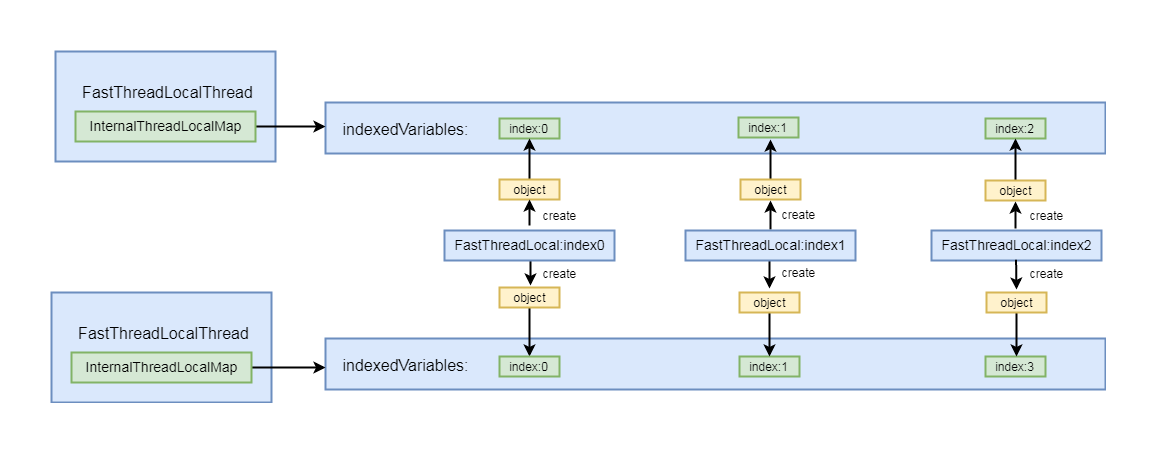Netty源码分析第八章: 高性能工具类FastThreadLocal和Recycler
概述:
FastThreadLocal我们在剖析堆外内存分配的时候简单介绍过, 它类似于JDK的ThreadLocal, 也是用于在多线程条件下, 保证统一线程的对象共享, 只是netty中定义的FastThreadLocal, 性能要高于jdk的ThreadLocal, 具体原因会在之后的小节进行剖析
Recyler我们应该也不会太陌生, 因为在之前章节中, 有好多地方使用了Recyler
Recyler是netty实现的一个轻量级对象回收站, 很多对象在使用完毕之后, 并没有直接交给gc去处理, 而是通过对象回收站将对象回收, 目的是为了对象重用和减少gc压力
比如ByteBuf对象的回收, 因为ByteBuf对象在netty中会频繁创建, 并且会占用比较大的内存空间, 所以使用完毕后会通过对象回收站的方式进行回收, 已达到资源重用的目的
这一章就对FastThreadLocal和Recyler两个并发工具类进行分析
第一节:FastThreadLocal的使用和创建
首先我们看一个最简单的demo:
public class FastThreadLocalDemo {
final class FastThreadLocalTest extends FastThreadLocal<Object>{
@Override
protected Object initialValue() throws Exception {
return new Object();
}
}
private final FastThreadLocalTest fastThreadLocalTest;
public FastThreadLocalDemo(){
fastThreadLocalTest = new FastThreadLocalTest();
}
public static void main(String[] args){
FastThreadLocalDemo fastThreadLocalDemo = new FastThreadLocalDemo();
new Thread(new Runnable() {
@Override
public void run() {
Object obj = fastThreadLocalDemo.fastThreadLocalTest.get();
try {
for (int i=0;i<10;i++){
fastThreadLocalDemo.fastThreadLocalTest.set(new Object());
Thread.sleep(1000);
}
}catch (Exception e){
e.printStackTrace();
}
}
}).start();
new Thread(new Runnable() {
@Override
public void run() {
try {
Object obj = fastThreadLocalDemo.fastThreadLocalTest.get();
for (int i=0;i<10;i++){
System.out.println(obj == fastThreadLocalDemo.fastThreadLocalTest.get());
Thread.sleep(1000);
}
}catch (Exception e){
}
}
}).start();
}
}
这里首先声明一个内部类FastThreadLocalTest继承FastThreadLocal, 并重写initialValue方法, initialValue方法就是用来初始化线程共享对象的
然后声明一个成员变量fastThreadLocalTest, 类型就是内部类FastThreadLocalTest
在构造方法中初始化fastThreadLocalTest
main方法中创建当前类FastThreadLocalDemo的对象fastThreadLocalDemo
然后启动两个线程, 每个线程通过fastThreadLocalDemo.fastThreadLocalTest.get()的方式拿到线程共享对象, 因为fastThreadLocalDemo是相同的, 所以fastThreadLocalTest对象也是同一个, 同一个对象在不同线程中进行get()
第一个线程循环通过set方法修改共享对象的值
第二个线程则循环判断并输出fastThreadLocalTest.get()出来的对象和第一次get出来的对象是否相等
这里输出结果都true, 说明其他线程虽然不断修改共享对象的值, 但都不影响当前线程共享对象的值
这样就实现了线程共享的对象的功能
根据上述示例, 我们剖析FastThreadLocal的创建
首先跟到FastThreadLocal的构造方法中:
public FastThreadLocal() {
index = InternalThreadLocalMap.nextVariableIndex();
}
这里的index, 代表FastThreadLocal对象的一个下标, 每创建一个FastThreadLocal, 都会有一个唯一的自增的下标
跟到nextVariableIndex方法中:
public static int nextVariableIndex() {
int index = nextIndex.getAndIncrement();
if (index < 0) {
nextIndex.decrementAndGet();
throw new IllegalStateException("too many thread-local indexed variables");
}
return index;
}
这里只是获取nextIndex通过getAndIncrement()进行原子自增, 创建第一个FastThreadLocal对象时, nextIndex为0, 创建第二个FastThreadLocal对象时nextIndex为1, 以此类推, 第n次nextIndex为n-1, 如图所示

8-1-1
我们回到demo中, 我们看线程中的这一句:
Object obj = fastThreadLocalDemo.fastThreadLocalTest.get();
这里调用了FastThreadLocal对象的get方法, 作用是创建一个线程共享对象
我们跟到get方法中:
public final V get() {
return get(InternalThreadLocalMap.get());
}
这里调用了一个重载的get方法, 参数中通过InternalThreadLocalMap的get方法获取了一个InternalThreadLocalMap对象
我们跟到InternalThreadLocalMap的get方法中, 分析其实如何获取InternalThreadLocalMap对象的
public static InternalThreadLocalMap get() {
Thread thread = Thread.currentThread();
if (thread instanceof FastThreadLocalThread) {
return fastGet((FastThreadLocalThread) thread);
} else {
return slowGet();
}
}
这里首先拿到当前线程, 然后判断当前线程是否为FastThreadLocalThread线程, 通常NioEventLoop线程都是FastThreadLocalThread, 用于线程则不是FastThreadLocalThread
在这里, 如果FastThreadLocalThread线程, 则调用fastGet方法获取InternalThreadLocalMap, 从名字上我们能知道, 这是一种效率极高的获取方式
如果不是FastThreadLocalThread线程, 则调用slowGet方式获取InternalThreadLocalMap, 同样根据名字, 我们知道这是一种效率不太高的获取方式
我们的demo并不是eventLoop线程, 所以这里会走到slowGet()方法中
我们首先剖析slowGet()方法:
private static InternalThreadLocalMap slowGet() {
ThreadLocal<InternalThreadLocalMap> slowThreadLocalMap = UnpaddedInternalThreadLocalMap.slowThreadLocalMap;
InternalThreadLocalMap ret = slowThreadLocalMap.get();
if (ret == null) {
ret = new InternalThreadLocalMap();
slowThreadLocalMap.set(ret);
}
return ret;
}
首先通过UnpaddedInternalThreadLocalMap.slowThreadLocalMap拿到一个ThreadLocal对象slowThreadLocalMap, slowThreadLocalMap是UnpaddedInternalThreadLocalMap类的一个静态属性, 类型是ThreadLocal类型
这里的ThreadLocal是jdk的ThreadLocal
然后通过slowThreadLocalMap对象的get方法, 获取一个InternalThreadLocalMap
如果第一次获取, InternalThreadLocalMap有可能是null, 所以在if块中, new了一个InternalThreadLocalMap对象, 并设置在ThreadLocal对象中
因为netty实现的FastThreadLocal要比jdk的ThreadLocal要快, 所以这里的方法叫slowGet
回到InternalThreadLocalMap的get方法:
public static InternalThreadLocalMap get() {
Thread thread = Thread.currentThread();
if (thread instanceof FastThreadLocalThread) {
return fastGet((FastThreadLocalThread) thread);
} else {
return slowGet();
}
}
我们继续剖析fastGet方法, 通常EventLoop线程FastThreadLocalThread线程, 所以EventLoop线程执行到这一步的时候会调用fastGet方法
我们跟进fastGet:
private static InternalThreadLocalMap fastGet(FastThreadLocalThread thread) {
InternalThreadLocalMap threadLocalMap = thread.threadLocalMap();
if (threadLocalMap == null) {
thread.setThreadLocalMap(threadLocalMap = new InternalThreadLocalMap());
}
return threadLocalMap;
}
首先FastThreadLocalThread对象直接通过threadLocalMap拿到threadLocalMap对象
如果threadLocalMap为null, 则创建一个InternalThreadLocalMap对象设置到FastThreadLocalThread的成员变量中
这里我们可以知道FastThreadLocalThread对象中维护了一个InternalThreadLocalMap类型的成员变量, 可以直接通过threadLocalMap()方法获取该变量的值, 也就是InternalThreadLocalMap
我们跟到InternalThreadLocalMap的构造方法中:
private InternalThreadLocalMap() {
super(newIndexedVariableTable());
}
这里调用了父类的构造方法, 传入一个newIndexedVariableTable()
我们跟到newIndexedVariableTable()中:
private static Object[] newIndexedVariableTable() {
Object[] array = new Object[32];
Arrays.fill(array, UNSET);
return array;
}
这里创建一个长度为32的数组, 并为数组中的每一个对象设置为UNSET, UNSET是一个Object的对象, 表示该下标的值没有被设置
回到InternalThreadLocalMap的构造方法, 再看其父类的构造方法:
UnpaddedInternalThreadLocalMap(Object[] indexedVariables) {
this.indexedVariables = indexedVariables;
}
这里初始化了一个数组类型的成员变量indexedVariables, 就是newIndexedVariableTable返回object的数组
这里我们可以知道, 每个InternalThreadLocalMap对象中都维护了一个Object类型的数组, 那么这个数组有什么作用呢?我们继续往下剖析
回到FastThreadLocal的get方法中:
public final V get() {
return get(InternalThreadLocalMap.get());
}
我们剖析完了InternalThreadLocalMap.get()的相关逻辑, 再继续看重载的get方法:
public final V get(InternalThreadLocalMap threadLocalMap) {
Object v = threadLocalMap.indexedVariable(index);
if (v != InternalThreadLocalMap.UNSET) {
return (V) v;
}
return initialize(threadLocalMap);
}
首先看这一步:
Object v = threadLocalMap.indexedVariable(index);
这一步是拿到当前index下标的object, 其实也就是拿到每个FastThreadLocal对象的绑定的线程共享对象
index是我们刚才分析过, 是每一个FastThreadLocal的唯一下标
我们跟到indexedVariable方法中:
public Object indexedVariable(int index) {
Object[] lookup = indexedVariables;
return index < lookup.length? lookup[index] : UNSET;
}
这里首先拿到indexedVariables, 我们刚才分析过, indexedVariables是InternalThreadLocalMap对象中维护的数组, 初始大小是32
然后再return中判断当前index是不是小于当前数组的长度, 如果小于则获取当前下标index的数组元素, 否则返回UNSET代表没有设置的对象
这里我们可以分析到, 其实每一个FastThreadLocal对象中所绑定的线程共享对象, 是存放在threadLocalMap对象中的一个对象数组的中的, 数组中的元素的下标其实就是对应着FastThreadLocal中的index属性, 对应关系如图所示

8-1-2
回到FastThreadLocal重载的get方法:
public final V get(InternalThreadLocalMap threadLocalMap) {
Object v = threadLocalMap.indexedVariable(index);
if (v != InternalThreadLocalMap.UNSET) {
return (V) v;
}
return initialize(threadLocalMap);
}
根据以上逻辑, 我们知道, 第一次获取对象v是只能获取到UNSET对象, 因为该对象并没有保存在threadLocalMap中的数组indexedVariables中, 所以第一次获取在if判断中为false, 会走到initialize方法中
跟到initialize方法中:
private V initialize(InternalThreadLocalMap threadLocalMap) {
V v = null;
try {
v = initialValue();
} catch (Exception e) {
PlatformDependent.throwException(e);
}
threadLocalMap.setIndexedVariable(index, v);
addToVariablesToRemove(threadLocalMap, this);
return v;
}
这里首先调用的initialValue方法, 这里的initialValue实际上走的是FastThreadLocal子类的重写initialValue方法
在我们的demo中对应这个方法:
@Override
protected Object initialValue() throws Exception {
return new Object();
}
通过这个方法会创建一个线程共享对象
然后通过threadLocalMap对象的setIndexedVariable方法将创建的线程共享对象设置到threadLocalMap中维护的数组中, 参数为FastThreadLocal和创建的对象本身
跟到setIndexedVariable方法中:
public boolean setIndexedVariable(int index, Object value) {
Object[] lookup = indexedVariables;
if (index < lookup.length) {
Object oldValue = lookup[index];
lookup[index] = value;
return oldValue == UNSET;
} else {
expandIndexedVariableTableAndSet(index, value);
return true;
}
}
这里首先判断FastThreadLocal对象的index是否超过数组indexedVariables的长度, 如果没有超过, 则直接通过下标设置新创建的线程共享对象, 通过这个操作, 下次获取该对象的时候就可以直接通过数组下标进行取出
如果index超过了数组indexedVariables的长度, 则通过expandIndexedVariableTableAndSet方法将数组扩容, 并且根据index的通过数组下标的方式将线程共享对象设置到数组indexedVariables中
以上就是线程共享对象的创建和获取的过程